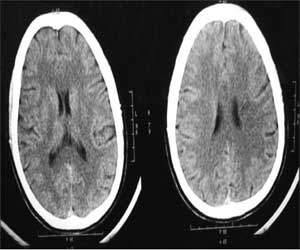- Home
- Editorial
- News
- Practice Guidelines
- Anesthesiology Guidelines
- Cancer Guidelines
- Cardiac Sciences Guidelines
- Critical Care Guidelines
- Dentistry Guidelines
- Dermatology Guidelines
- Diabetes and Endo Guidelines
- Diagnostics Guidelines
- ENT Guidelines
- Featured Practice Guidelines
- Gastroenterology Guidelines
- Geriatrics Guidelines
- Medicine Guidelines
- Nephrology Guidelines
- Neurosciences Guidelines
- Obs and Gynae Guidelines
- Ophthalmology Guidelines
- Orthopaedics Guidelines
- Paediatrics Guidelines
- Psychiatry Guidelines
- Pulmonology Guidelines
- Radiology Guidelines
- Surgery Guidelines
- Urology Guidelines
An unusual case of lacunar stroke with oral contraceptives

The authors reported a case of an arterial ischemic stroke due to lacunar infarction in a 35-year-old previously healthy female patient induced after 3 years on 'Sukhi', an oral contraceptive after two times artificial abortions. The case has been published in the Journal of Mid-life Health.
Combined oral contraceptives are one of the risk factor for stroke in women. Lacunar stroke is a type of ischemic stroke that occurs when blood flow to one of the small arteries deep within the brain becomes blocked.
According to the National Institutes of Health (NIH), lacunar strokes represent about one-fifth of all strokes.
According to history, a 35-year-old female patient on 'Sukhi' for contraception for the last 3 years presented to the Emergency Department with complaints of sudden onset (45 min earlier) of slight paralysis of the right side of her body and the inability to express herself by speech, writing, or signs. She was afebrile, alert, oriented with blood pressure of 122/98 mm Hg, pulse rate 100/min. She was a non-smoker, not a known diabetic or hypertensive, but there was history of repeated abortions in the past.
General physical examination was normal with normal intact memory. Fundoscopic findings were normal although neurological examination revealed right-sided hemiparesis with upward right babinski reflex. On investigations, the parameters such as hemogram, ESR, random blood sugar, kidney function tests, liver function tests, electroencephalogram, electrocardiogram, serum cholesterol, serum electrolytes, urine analysis and X-ray chest were within normal limits.
Plasma amino acid, vascular profile, and metabolic profile; including levels of homocysteine, ammonia, and lactate; were also within normal limits. Hemoglobin electrophoresis also revealed normal bands. Additional tests such as prothrombin time, activated partial thromboplastin time, antinuclear antibody test, anticardiolipin antibody immunoglobulin levels, protein C level and antithrombin III levels were within normal limits.
However a non-contrast enhanced computed tomography of brain showed a LACI which was confirmed on a magnetic resonance imaging scan. The patient was then hospitalized and treated with intravenous unfractionated heparin, which was then switched on to subcutaneous enoxaparin. After 7 days, her condition completely improved and she was discharged with oral warfarin.
For more details click on the link: DOI: 10.4103/0976-7800.118996

Disclaimer: This site is primarily intended for healthcare professionals. Any content/information on this website does not replace the advice of medical and/or health professionals and should not be construed as medical/diagnostic advice/endorsement or prescription. Use of this site is subject to our terms of use, privacy policy, advertisement policy. © 2020 Minerva Medical Treatment Pvt Ltd